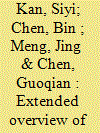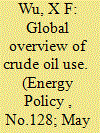|
|
|
Sort Order |
|
|
|
Items / Page
|
|
|
|
|
|
|
| Srl | Item |
| 1 |
ID:
171357


|
|
|
|
|
| Summary/Abstract |
As an extension of our previous study on natural gas use in world economy (Kan et al., Energy Policy 124 (2019) 215–225), this paper explores policy implications based on a time series analysis uncovering the evolution of natural gas use embodied in global supply chains during 2000-2011. Due to increasing gas supply from gas-rich regions to gas-scarce regions and outsourcing of energy-intensive industries, trade imbalance of embodied natural gas is intensifying globally, corresponding to strengthening gas resource relocation and environmental stress shift. Regarding trade patterns, EU and Russia remain the leading (net) importer and exporter of embodied gas, respectively. And global trade relations are diversifying over time, with more suppliers and recipients joining the international trade. Based on the New Policies Scenario provided by IEA, a long term forecast of embodied gas use illustrates need to prepare for a world with changing energy mix, with respect to growing availability of low-cost natural gas and robust demand growth coming from emerging economies, especially China, who is struggling to fight against air pollution through coal-to-gas switch. Potential room to expand natural gas utilization is also targeted, and the expansion requires coordination of all the agents in global supply chains.
|
|
|
|
|
|
|
|
|
|
|
|
|
|
|
|
| 2 |
ID:
111482


|
|
|
|
|
| Publication |
2012.
|
| Summary/Abstract |
Economists have recently become interested in weighting how much domestic value-added is actually included in China's exports. Formally, the proportion of foreign and domestic contents could be identified by calculating the vertical specialization share using non-competitive input-output tables. Applying such a method to the Chinese case, however, would result in a big measurement bias because China has a large share of processing exports, which utilize a disproportionately high percentage of imported intermediates. This paper, by directly employing 2008 trade data for which imported intermediates in both processing and non-processing trade could be identified by means of various trade patterns, provides a simplified way to estimate the share of foreign/domestic value-added included in industry-level manufactured exports. This paper finds that the vertical specialization share of China's processing exports was about 56 percent in 2008, compared to about 10 percent for ordinary exports. It also finds that the sectors that experienced fast expansion of processing exports have a much higher share of foreign contents. Since processing exports account for about half of Chinese exports, the prevailing trade statistics, which focus on gross values rather than the value-added of exports and imports, has obviously overstated the bilateral trade imbalances, especially between China and the USA.
|
|
|
|
|
|
|
|
|
|
|
|
|
|
|
|
| 3 |
ID:
166344


|
|
|
|
|
| Summary/Abstract |
This paper conducts a systems input-output analysis to form an overview of crude oil use in the globalized world economy in 2015. The use of crude oil is tracked from the sources of exploitation to the sinks of final use through the channels of inter-regional trade. This paper finds that the top five oil users, the United States, Mainland China, Japan, South Korea and Canada, are together responsible for half of global oil use. The global volume of oil embodied in trade is twenty percent larger than that in oil exploitation, and the role of the trade of non-oil goods in the global oil balance is comparable to that of the direct oil trade. The United States is the biggest net importer of oil use, in contrast to Mainland China, which is the biggest net importer of direct oil. In order to characterize a region's energy security, new indices for its dependence on external sources of oil are devised. The inter-regional transfer of the environmental burden associated with oil use, leading to the dilemma of “regional decrease at the expense of global increase”, is shown to be inherent to existing energy strategies.
|
|
|
|
|
|
|
|
|
|
|
|
|
|
|
|
| 4 |
ID:
079134


|
|
|
|
|
| Publication |
2007.
|
| Summary/Abstract |
Over the last three decades, the East Asian industry transfer has, via foreign direct investment (FDI), transformed China from an autarky into an integral player in the East Asian production chain. As a last-stage assembler in this value-added chain, China is maintaining an increasingly high trade surplus with the United States. The worsening U.S.-China trade disputes are addressed in such a politicized way that "fair" trade has become the central issue of bilateral trade consultation. However, due to its enormous labor force and impressive macroeconomic prospects, China will continue to play its current role as a world assembly center. Our statistical analysis further substantiates the theoretical hypothesis that the East Asian industry transfer has a strong export transfer effect. Therefore, it is unlikely that the U.S.-China trade imbalance will be alleviated fundamentally in the next five to ten years. Trade disputes between Beijing and Washington will continue to be a big headache and both sides need to tackle the problem through more dialogue and negotiation
|
|
|
|
|
|
|
|
|
|
|
|
|
|
|
|
| 5 |
ID:
100259


|
|
|
|
|
| Publication |
2010.
|
| Summary/Abstract |
The paper sets up a small open economy general equilibrium model to study the dynamics of the adjustment of trade imbalances under different policies based on the Chinese economy. The policies that adjust domestic prices require a long period to achieve trade balance and induce fluctuations of output and inflation, regardless of whether capital markets are open or closed, while policies that adjust the exchange rate quickly result in diminished trade surpluses, and do not cause fluctuations of output and inflation. However, policies that adjust the exchange rate slowly also lead to fluctuations under a capital flow setting. Nominal frictions are important factors to these differences, because they slow down the price adjustment, but do not bother the exchange rate changes. From the perspective of welfare, fast exchange rate adjustment policies are better than price policies, and adjustment under capital flow is better than adjustment under capital control. The implications for China's trade surplus are analyzed.
|
|
|
|
|
|
|
|
|
|
|
|
|
|
|
|
|
|
|
|
|